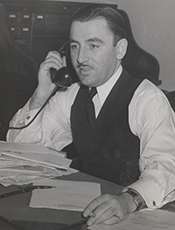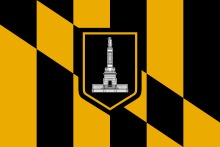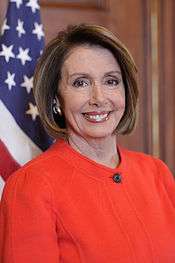Thomas D'Alesandro Jr.
| Thomas D'Alesandro Jr. | |
|---|---|
 | |
| 39th Mayor of Baltimore | |
|
In office May 16, 1947 – May 16, 1959 | |
| Preceded by | Theodore R. McKeldin |
| Succeeded by | J. Harold Grady |
| Member of the U.S. House of Representatives from Maryland's 3rd district | |
|
In office January 3, 1939 – May 16, 1947 | |
| Preceded by | Vincent L. Palmisano |
| Succeeded by | Edward Garmatz |
| Member of the Baltimore City Council | |
|
In office 1935–1938 | |
| Member of the Maryland House of Delegates | |
|
In office 1926-1933 | |
| Personal details | |
| Born |
Thomas Ludwig John D'Alesandro Jr. August 1, 1903 Baltimore, Maryland, U.S. |
| Died |
August 23, 1987 (aged 84) Baltimore, Maryland, U.S. |
| Political party | Democratic |
| Spouse(s) | Nancy Lombardi |
| Children | 6, including Nancy Pelosi |
| Profession | Legislator, politician |
Thomas Ludwig John D'Alesandro Jr. (August 1, 1903 – August 23, 1987) was an American politician who was a U.S. Representative from Maryland's 3rd congressional district (1939–47) and subsequently the mayor of Baltimore, Maryland (1947–59). He was the father of former House Speaker and current House Minority Leader Nancy Pelosi.
Biography
D'Alesandro was born in Baltimore, Maryland, the son of Maria Petronilla (née Foppiani) and Tommaso G. D'Alesandro, who were born in Montenerodomo, Abruzzo, South Italy. He was married to Annunciata M. ("Nancy") Lombardi.[1] The couple had six children: five sons and a daughter. D'Alesandro attended Calvert Business College in Baltimore. Before beginning his political career, he worked as a broker and in insurance, a career he returned to after his political service.
A Democrat, D'Alesandro served as a member of the Maryland State House of Delegates from 1926 to 1933. After serving in Annapolis, D'Alesandro was then appointed as General Deputy Collector of Internal Revenue, a post in which he served during 1933–1934. He then was elected to serve on the Baltimore City Council from 1935 to 1938.
D'Alesandro was then elected to the 76th Congress and to the four succeeding Congresses, serving from January 3, 1939, until he resigned on May 16, 1947. While in Congress, D'Alesandro strongly supported the Bergson Group, a "political action committee set up to that challenged the Roosevelt Administration's policies on the Jewish refugee issue during the Holocaust, and later lobbied against British control of Palestine" despite his equally strong support for Roosevelt's other policies.[2]
Mayor of Baltimore
Following his service in Congress he was Mayor of Baltimore for 12 years from May 1947 to May 1959.[3]
Political campaigns
D'Alesandro was a strong contender for Governor of Maryland in 1954, but was forced to drop out due to being implicated in receiving undeclared money from Dominic Piracci, a parking garage owner convicted of fraud, conspiracy, and conspiracy to obstruct justice.[4] D'Alesandro was later exonerated and never indicted. It seems the association fallacy was either due to D'Alesandro's Italian heritage or his personal strength.[5] Rather than lose the election, D'Alesandro withdrew and tacitly supported University of Maryland President Curley Byrd who would go onto lose by 54.46% to 45.54% to the Republican incumbent and D'Alesandro's predecessor as Mayor of Baltimore Theodore McKeldin. McKeldin would later defeat the man who defeated D'Alesandro for mayor and then would be succeeded as mayor by D'Alesandro's son.
In 1958, D'Alesandro ran for the United States Senate in a bid to defeat Republican incumbent J. Glenn Beall who in 1952 defeated perennial candidate/contractor George P. Mahoney. D'Alesandro had to first spend money and time dispatching the fiery Mahoney in the Democratic primary. D'Alesandro then ran a strong and close, but eventually unsuccessful campaign, against Beall. This was the first time D'Alesandro ever lost an election.[3]
In 1959, D'Alesandro narrowly was defeated in a bid for another term for Mayor of Baltimore by J. Harold Grady.[6]
Neo-Confederate criticism
In 2017, neo-confederate and conservative commentators attempted to embarrass D'Alesandro's daughter, House Minority Leader Nancy Pelosi, by pointing out in 1948, her father dedicated the Stonewall Jackson and Robert E. Lee Monument along with the then-Governor of Maryland, William Preston Lane Jr. which D'Alesandro as Mayor of Baltimore did as a function of his office.[7] But there is no evidence D'Alesandro supported racial division or was ever a segregationist. His son, Thomas D'Alesandro III, who later served as Mayor of Baltimore from 1967 to 1971, said about his father "His whole life was politics. He was not what you would call a flaming liberal, but he was a progressive."[3]
Legacy
- D'Alesandro's daughter, Nancy Pelosi, is a Representative from California, who served as the House of Representatives House Minority Leader between 2003 and 2007 and from 2011 to present, and was the Speaker of the House from January 4, 2007 until January 3, 2011.
- D'Alesandro's son, Thomas L. J. D'Alesandro III, also served as Mayor of Baltimore from 1967 to 1971.
See also
References
- ↑ Baltimore Sun, 1 October 1928, p. 20.
- ↑ Medoff, Rafael, "Pelosi's father and the Holocaust." Jerusalem Post. 11 April 2007. 16 April 2007.
- 1 2 3 Valentine, Paul W. (August 24, 1987). "BALTIMORE POLITICAL PATRIARCH THOMAS J. D'ALESANDRO JR. DIES". Retrieved December 18, 2017 – via www.WashingtonPost.com.
- ↑ "The Little World of Tommy" ,Time. 26 April 1954.
- ↑ Saxon, Wolfgang (August 24, 1987). "T. D'Alesandro Jr., a Baltimore Mayor, Dies". Retrieved December 18, 2017 – via NYTimes.com.
- ↑ "J. Harold Grady, mayor, chief judge, dies at 84". BaltimoreSun.com. Retrieved December 18, 2017.
- ↑ Singman, Brooke (August 24, 2017). "Nancy Pelosi's dad helped dedicate Confederate statue". The New York Post. Retrieved August 26, 2017.
External links
- United States Congress. "Thomas D'Alesandro Jr. (id: D000007)". Biographical Directory of the United States Congress.
- Thomas D'Alesandro Jr. at Find a Grave
- "T. D'Alesandro Jr., a Baltimore Mayor, Dies". The New York Times. August 24, 1987.
| U.S. House of Representatives | ||
|---|---|---|
| Preceded by Vincent L. Palmisano |
Member of the U.S. House of Representatives from Maryland's 3rd congressional district 1939–1947 |
Succeeded by Edward Garmatz |
| Political offices | ||
| Preceded by Theodore R. McKeldin |
Mayor of Baltimore 1947–1959 |
Succeeded by J. Harold Grady |
| Party political offices | ||
| Preceded by George P. Mahoney |
Democratic nominee for United States Senator from Maryland (Class 1) 1958 |
Succeeded by Joseph Tydings |
| 76th | Senate: Tydings • Radcliffe | House: Cole • Kennedy • Byron • D'Alesandro • Sasscer • Ward |
| 77th | Senate: Tydings • Radcliffe | House: Cole • W. Byron • D'Alesandro • Sasscer • Ward • Meyer • K. Byron |
| 78th | Senate: Tydings • Radcliffe | House: D'Alesandro • Sasscer • Ward • Baldwin • Beall • Ellison |
| 79th | Senate: Tydings • Radcliffe | House: D'Alesandro • Sasscer • Baldwin • Beall • Fallon • Roe |
| 80th | Senate: Tydings • O'Conor | House: D'Alesandro • Sasscer • Beall • Fallon • Meade • Miller |

